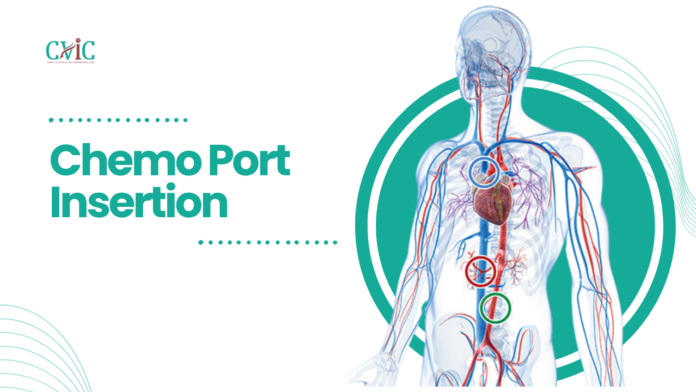Chemotherapy port insertion is a significant procedure for many patients undergoing cancer treatment, offering a safer, more comfortable, and efficient method to administer chemotherapy drugs, blood products, antibiotics, and nutritional supplements. This blog aims to provide a comprehensive overview of chemotherapy port insertion, including what it is, the benefits, the procedure itself, recovery, and care for the port.
What is a Chemotherapy Port?
A chemotherapy port, often simply called a “port,” is a small, implantable device that provides easy access to a patient’s veins, reducing the need for repeated needle sticks. It consists of a port (a small disc made of plastic or metal) and a tube that goes into a vein. Ports are usually placed under the skin in the upper chest or sometimes in the arm.

Benefits of Using a Chemo Port
The primary benefits of using a chemo port include:
Reduced Discomfort: Since the port is accessed through the skin, patients experience less discomfort than they would with traditional IV lines or needle sticks.
Lowered Infection Risk: The risk of infection is significantly reduced as the port is under the skin, and proper care and maintenance can keep the area clean and sterile.
Long-Term Use: Ports can remain in place for the duration of a patient’s treatment, which can be months or even years, avoiding the need for frequent venous access.
Improved Quality of Life: Ports allow patients more freedom and comfort during treatment sessions and reduce anxiety associated with needle sticks.
The Procedure for Inserting a Chemo Port
The insertion of a chemo port is typically done as an outpatient procedure, meaning you can go home the same day. The process involves the following steps:
Preparation: Before the procedure, you’ll undergo a physical examination, and your medical history will be reviewed. Blood tests might be required to ensure you’re fit for the procedure.
Anesthesia: Local anesthesia is used to numb the area where the port will be inserted. In some cases, sedation might also be offered.
Insertion: A small incision is made on the upper chest (or arm), and a pocket under the skin is created to hold the port. The tube (catheter) is threaded into a large vein, typically the superior vena cava, near the heart. The port is then connected to this catheter.
Closure: The incision is closed with sutures, and a dressing is applied. The procedure usually takes about an hour.

Recovery and Aftercare
Post-procedure, patients might feel some discomfort or bruising around the incision site, but this typically subsides within a few days. It’s crucial to follow the care instructions provided by your healthcare team, which may include:
- Keeping the insertion site clean and dry.
- Monitoring for signs of infection (redness, swelling, or fever).
- Avoiding heavy lifting or strenuous activities for a short period.
Using and Caring for Your Chemo Port
Before using the port for chemotherapy or other treatments, a healthcare professional will verify its placement and function. When accessing the port, a special needle is used to ensure that treatments are delivered directly into the bloodstream with minimal discomfort.
Regular flushing of the port with saline or a heparin solution may be necessary to prevent clotting when the port is not in use. Your healthcare team will provide detailed instructions on how often this should be done.

Conclusion
A chemotherapy port is a valuable option for many patients undergoing long-term treatment, offering a less painful and more convenient way to receive medications. While the idea of having a device implanted can be daunting, the benefits it provides in reducing discomfort and improving the quality of life during chemotherapy are significant. Always discuss with your oncologist or healthcare provider to understand if a chemo port is the right choice for you and how to best care for it throughout your treatment journey.
Our Doctors
Dedicated IR Center for Vascular Problems in Madhya Pradesh
DR. SHAILESH GUPTA
MD, PDCC (INTERVENTIONAL RADIOLOGY) Consultant & Co-Director CVIC (Center Of Vascular & Interventional Care)
DR. ALOK KUMAR UDIYA
MD Radiology, PDCC (Neuro intervention Radiology), PDCC ( HPB Intervention Radiology) FINR (Switzerland) & EBIR
Endovascular Surgeon & Consultant Interventional Neuroradiologist at Care CHL Hospital, Indore Co-director CVIC( center for vascular and interventional care) https://interventionradiologyindore.com/
DR. NISHANT BHARGAVA
Consultant Intervention Radiologist
MD Radiology, PDCC ( Neuro intervention Radiology), FINR ( Fellowship in Neuro intervention Radiology)
Co-director CVIC(Center for Vascular and Interventional Care)
Contact Details
Phone no.
0731 4675670
+91 9827760073
Facebook
https://www.facebook.com/profile.php?id=100092538633553&mibextid=ZbWKwL
Instagram
https://instagram.com/cvic_center?igshid=ZGUzMzM3NWJiOQ==
Google My business
https://g.co/kgs/DrdV3T
YouTube
https://www.youtube.com/channel/UCP5TH5e4iQZkpDUgnLsgZhw
Pinterest
https://pin.it/5DzpX5Z
Twitter
https://x.com/cviccenter?t=01TclSrLFdu0K2re0Gs96w&s=08
LINKEDIN
https://www.linkedin.com/company/center-of-vascular-interventional-care/
Location –
Read More –
Tumor Biopsies in Oncology Intervention – https://cvicvascular.com/tumor-biopsies-in-oncology-intervention/
Radiofrequency Ablation (RFA) in Oncology Intervention – https://cvicvascular.com/radiofrequency-ablation-rfa-in-oncology-intervention/
Chemo Embolization – https://cvicvascular.com/chemo-embolization/




